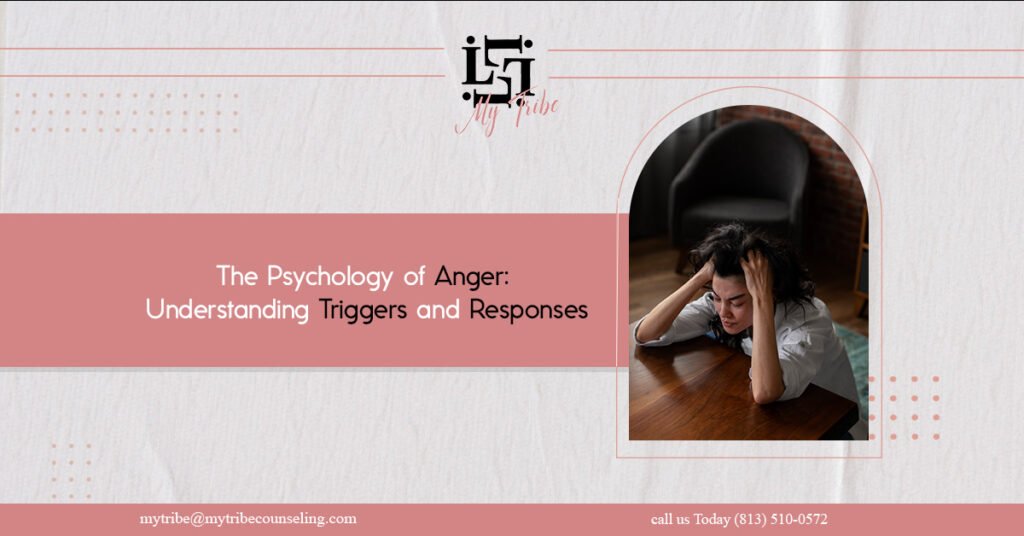Around 70 % of adults experience anger at least once a month, making it one of the most common emotions. Although often seen as a negative feeling, this basic human emotion serves valuable psychological and bodily roles when it is correctly understood and handled.
This thorough review explores the psychological mechanisms that underlie anger, such as neurobiological pathways, external and internal triggers, and research‑backed management techniques. By systematically studying the psychology of anger, people can build stronger emotional regulation abilities and healthier relationships.
What is Anger? A Psychological Overview
Anger is a basic emotional reaction marked by displeasure, hostility, or opposition toward perceived threats or unfairness. Evolutionarily, anger had adaptive purposes, allowing individuals to respond to environmental hazards and social disputes.
Modern psychological research differentiates between adaptive and maladaptive expressions of anger. Adaptive anger helps with problem solving, spurs corrective action, and signals necessary boundaries. In contrast, maladaptive anger leads to harmful behaviors, strained relationships, and adverse health effects.
Psychometric tools such as the State‑Trait Anger Expression Inventory‑2 (STAXI‑2) assess anger intensity, frequency, and how it is expressed. These standardized instruments allow clinicians to profile a person’s anger and design tailored interventions.
Theoretical models from psychodynamic, cognitive‑behavioral, and humanistic viewpoints provide complementary accounts of how anger develops and is expressed. Cognitive‑behavioral models stress the importance of appraisal in triggering anger, whereas psychodynamic approaches explore unconscious conflicts and defenses. Viewing anger as a multidimensional construct supports more effective therapy and self‑regulation techniques.
The Neurobiological Basis of Anger
Activating anger engages intricate neurobiological pathways centered in the limbic system, especially the amygdala, which acts as the brain’s threat detector. When possible threats are spotted, the amygdala triggers swift physiological reactions via the hypothalamic‑pituitary‑adrenal (HPA) axis.
The sympathetic nervous response includes a faster heartbeat, higher blood pressure, muscle tightness, and boosted cortisol release. These bodily shifts ready the body for defensive action, known as the fight‑or‑flight response.
Ongoing anger activation causes prolonged high levels of stress hormones, especially cortisol and adrenaline, linked to greater risks of heart disease, immune issues, and mental health problems like anxiety and depression.
Neuroimaging research shows changed brain activity in people with chronic anger, such as lower prefrontal cortex activation and overactive amygdala responses. These results support targeted interventions that emphasize cognitive regulation and mindfulness techniques.
Clinical manifestations of anger include:
- Physical signs: rapid heartbeat, high blood pressure, muscle tightness, sweating
- Emotional signs: irritability, frustration, sense of unfairness
- Behavioral signs: verbal hostility, physical aggression, withdrawal from social interactions
Being aware of these neurobiological processes allows people to apply early interventions before anger escalates.
Identifying Common Anger Triggers
Systematically pinpointing anger triggers is a vital part of a successful anger‑management program. Triggers include both external environmental factors and internal psychological processes that provoke angry reactions.
Self‑monitoring methods, such as structured anger logs and behavior assessments, aid in recognizing patterns and identifying triggers. These instruments help people develop anticipatory awareness and apply preventive measures.
External Environmental Triggers
External triggers arise from situational factors outside a person’s control. Research has identified several categories of external anger triggers:
- Interpersonal conflicts are the most common external triggers, encompassing criticism, perceived disrespect, betrayal, or boundary breaches in both personal and work relationships.
- Environmental stressors include traffic jams, noisy surroundings, crowded spaces, and time pressures that surpass personal tolerance limits.
- Perceived injustices involve discriminatory behavior, unfair policies, or systemic inequities that clash with personal values or expectations.
Typical external triggers involve:
- Critical comments from bosses or family members
- Money‑related stress and surprise expenses
- Social discrimination or bias
- Tech glitches and service breakdowns
Internal Psychological Triggers
Internal triggers arise from personal thoughts, emotional states, and bodily conditions. They often interact with external situations, magnifying angry reactions.
Cognitive distortions, such as catastrophic thinking, black‑and‑white reasoning, and personalization, boost anger susceptibility. These unhelpful thoughts exaggerate perceived threats and hamper effective coping.
Unresolved trauma and adverse childhood experiences heighten sensitivity to certain triggers, causing disproportionately strong anger to minor provocations. Physical factors like lack of sleep, poor nutrition, hormonal swings, and medical conditions can lower anger thresholds and raise emotional reactivity.
Typical internal triggers include:
- Perfectionism and fear of failing
- Low self‑esteem and hypersensitivity to rejection
- Unresolved grief and loss
- Ongoing pain and bodily discomfort
Understanding Psychological Responses to Anger
Anger reactions follow recognizable patterns that involve cognitive appraisal, emotional activation, and behavioral expression. The anger response cycle comprises trigger identification, cognitive assessment, physiological activation, behavioral reaction, and consequences appraisal. Individual response patterns differ according to personality traits, learned habits, cultural background, and neurobiology. Grasping these patterns supports tailored intervention strategies.
Immediate Psychological Responses
Initial anger reactions involve cognitive, emotional, and physiological elements that happen at the same time when anger ignites. Cognitive appraisal dictates how intense and long an anger response lasts. People who view situations as deliberate threats tend to feel stronger, longer‑lasting anger compared with those who entertain alternative explanations.
|Secondary emotions often accompany anger, such as hurt, fear, disappointment, and shame. Identifying these underlying feelings aids in thorough emotional processing and resolution.
Typical immediate response patterns include:
- Rumination: repeatedly dwelling on anger‑inducing thoughts
- Displacement: shifting anger toward safer targets
- Suppression: consciously holding back anger
- Projection: assigning one’s anger to someone else
Long‑term Psychological Consequences
Untreated chronic anger brings major adverse effects on mental health, physical health, and social connections. Long‑term studies show higher risks of depression, anxiety, substance abuse, and heart disease among those with ongoing anger issues.
Repeated anger episodes often erode relationships, resulting in social isolation, family dysfunction, and work problems. Loss of trust and communication breakdowns fuel ongoing interpersonal conflict.
Psychological resilience wanes with chronic anger, diminishing coping skills, and increased vulnerability to future stress. This cycle leads to progressive decline in overall functioning.
Red flags for problematic anger patterns include:
- Frequent anger episodes that interfere with daily life
- Growing social withdrawal and relationship clashes
- Escalating to verbal or physical aggression
- Emergence of co‑occurring mental health issues
Evidence‑Based Strategies for Anger Management
Effective anger control needs comprehensive approaches that target the cognitive, behavioral, and physiological aspects of anger. Research‑backed interventions have proven effective at lowering how often anger occurs, its intensity, and its harmful outcomes. Seeking professional help from licensed mental‑health practitioners is advisable for those with severe anger issues or a risk of aggression.
Cognitive Therapeutic Techniques
Cognitive techniques aim to change unhelpful thought patterns that feed anger activation and persistence. These approaches have strong empirical backing from clinical trials. Cognitive restructuring entails spotting and disputing irrational beliefs, catastrophic interpretations, and other cognitive distortions.
Mindfulness‑Based Interventions
Mindfulness‑centered techniques increase awareness of the present moment and curb repetitive rumination. Practices such as mindfulness meditation, body‑scan exercises, and breath‑focused routines reliably lower physiological arousal and foster better emotional regulation.
Implementation Tactics
- Daily monitoring of thoughts coupled with cognitive‑challenging drills
- Progressive muscle relaxation paired with diaphragmatic breathing exercises
- Consistent mindfulness meditation (at least 10–15 minutes each day)
- Cultivation of balanced self‑talk and reinforcing positive affirmations
Behavioral Intervention Approaches
Behavioral methods target unhelpful actions while encouraging constructive expression of anger. These strategies emphasize skill‑building and adjustments to the surrounding environment.
- Assertiveness training teaches appropriate communication for voicing needs, setting boundaries, and raising concerns without resorting to aggression. Clients rehearse respectful conflict‑resolution and negotiation tactics.
- Physical activity and movement serve as healthy outlets for excess arousal and help lower stress‑hormone levels. Regular aerobic exercise offers marked advantages for mood regulation and overall mental health.
- Time‑out procedures help individuals detect early warning signs and temporarily step away from anger‑provoking contexts before escalation.
Behavioral Modification Techniques
- Structured communication drills and role‑play scenarios
- Scheduled physical‑activity regimen (minimum 150 minutes per week)
- Environmental tweaks to lessen exposure to known triggers
- Building social‑support networks and accountability frameworks
Comprehensive Prevention Strategies
Sustained anger‑management success hinges on lifestyle changes that address core vulnerability factors and nurture emotional well-being.
- Sleep hygiene optimization ensures sufficient restorative sleep (7–9 hours nightly), preserving the capacity for emotional regulation. Sleep loss markedly raises anger susceptibility and diminishes coping efficacy.
- Nutritional interventions aim to stabilize blood‑glucose levels and supply essential nutrients for optimal neurobiological function. Regular meals and limited caffeine intake support emotional steadiness.
- Stress‑management programs incorporate relaxation methods, time‑management skills, and work-life balance tactics to lower overall stress load and mitigate anger triggers.
Professional Therapy Options
Evidence‑based treatments such as Cognitive‑Behavioral Therapy (CBT), Dialectical Behavior Therapy (DBT), and structured anger‑management groups provide systematic skill development and ongoing support.
Preventive Measures
- Consistent sleep schedules and optimized bedroom environments
- Balanced nutrition plans with regular meal timing
- Stress‑relief activities like yoga, meditation, or nature exposure
- Routine mental‑health check‑ins and professional assistance
Conclusion
The psychology of anger involves intricate interactions among neurobiological mechanisms, environmental provocations, cognitive appraisals, and behavioral responses. Grasping these dynamics enables individuals to adopt effective anger‑management tactics and enhance overall emotional health. Research‑backed interventions—spanning cognitive restructuring, behavioral modification, and lifestyle adjustments—demonstrate strong efficacy in curbing maladaptive anger patterns. Early detection and timely intervention help avert long‑term adverse effects on mental health relationships, and physical well-being.
Effective anger management demands consistent practice, professional guidance when necessary, and a commitment to ongoing personal growth. By systematically applying evidence‑based strategies, people can transform anger from a destructive force into a manageable component of their emotional experience.

